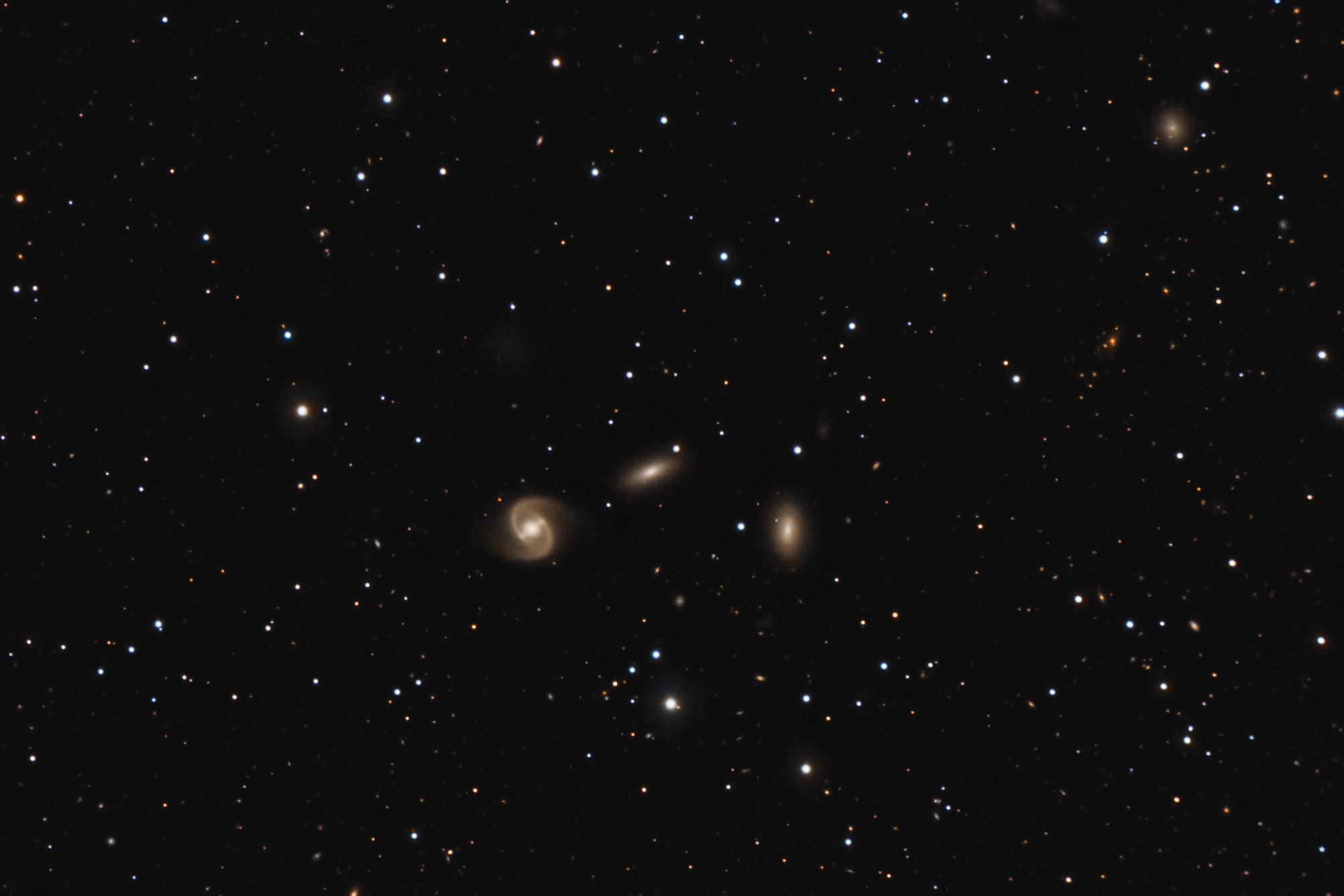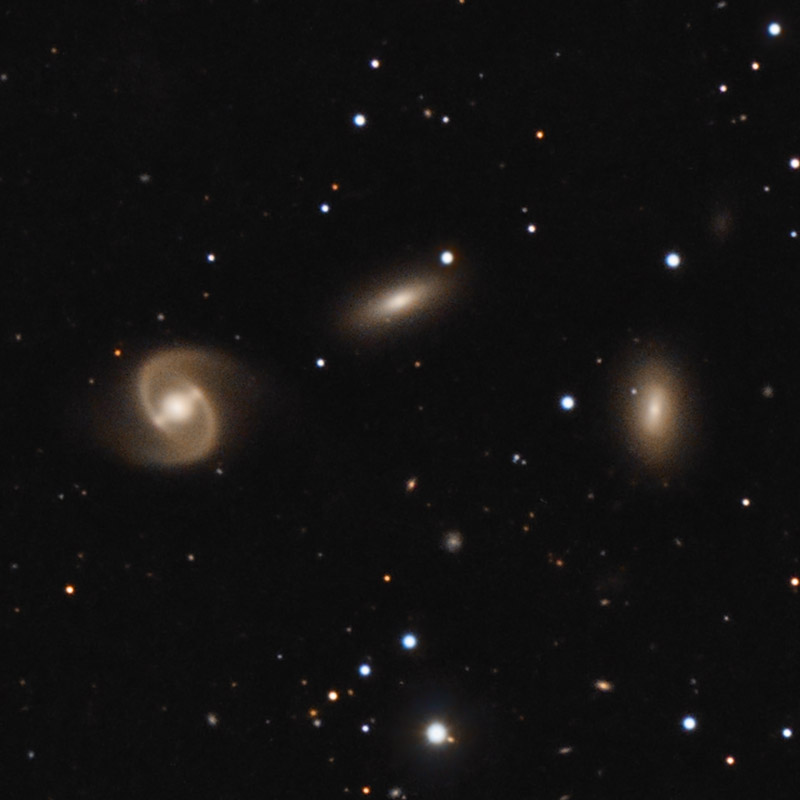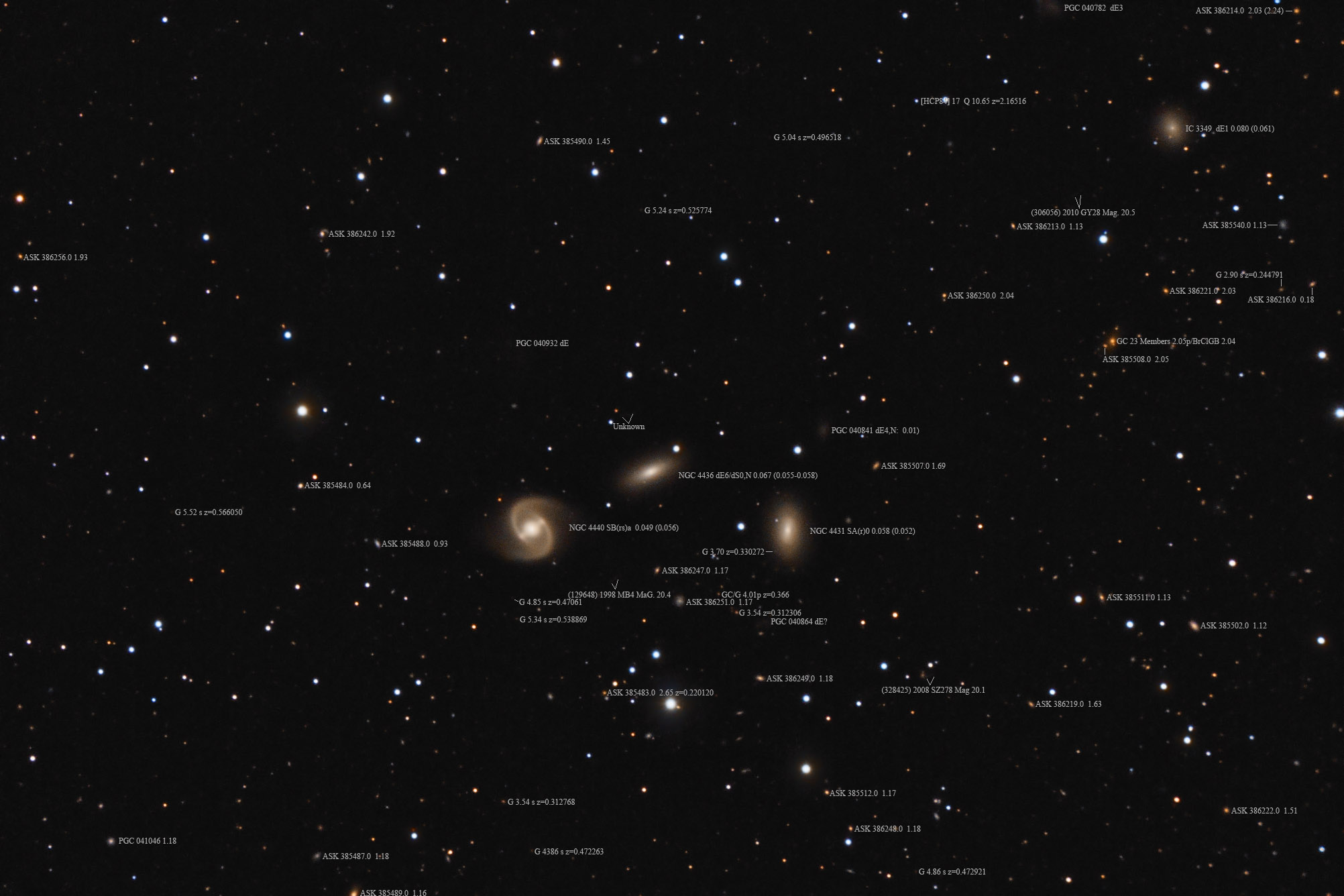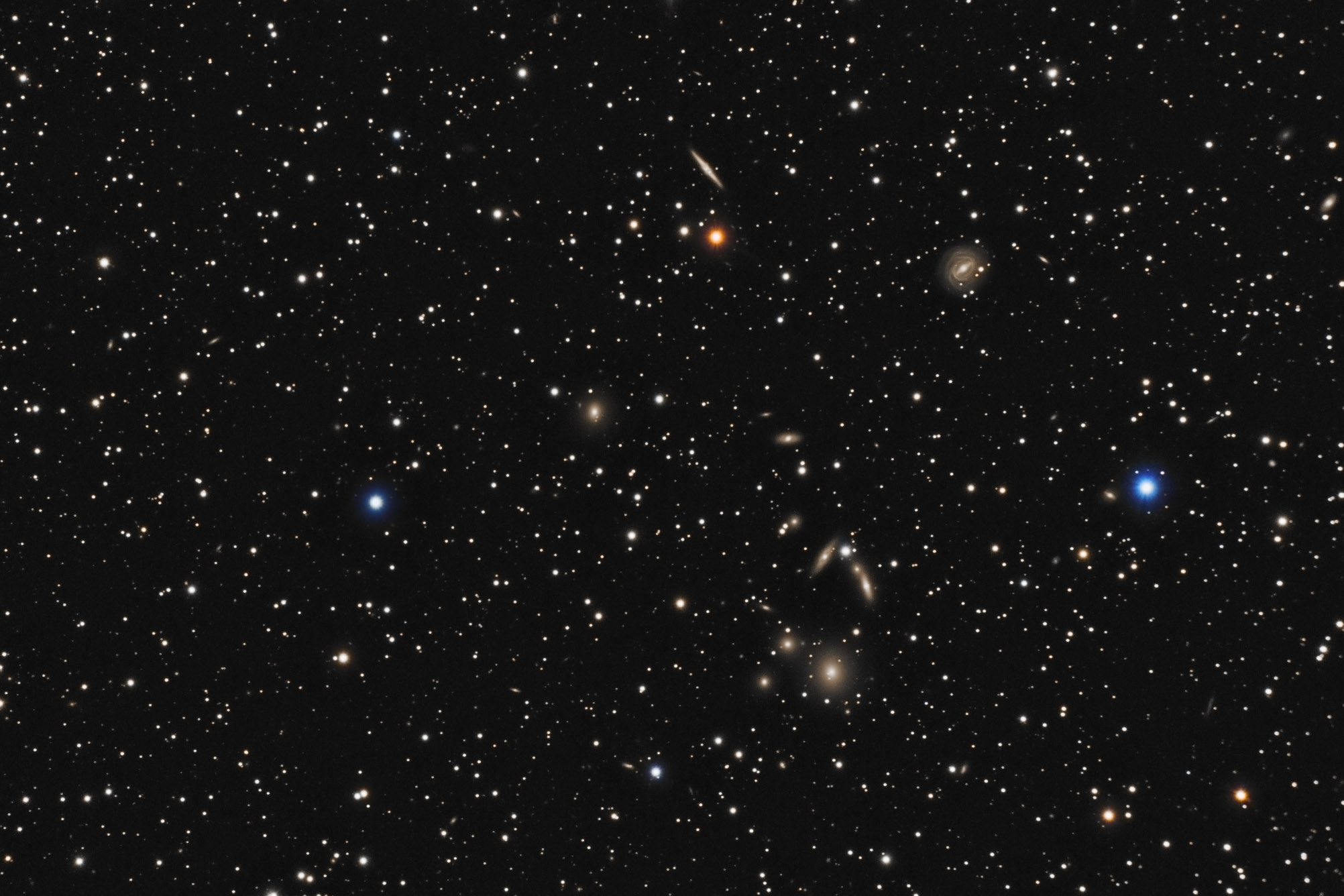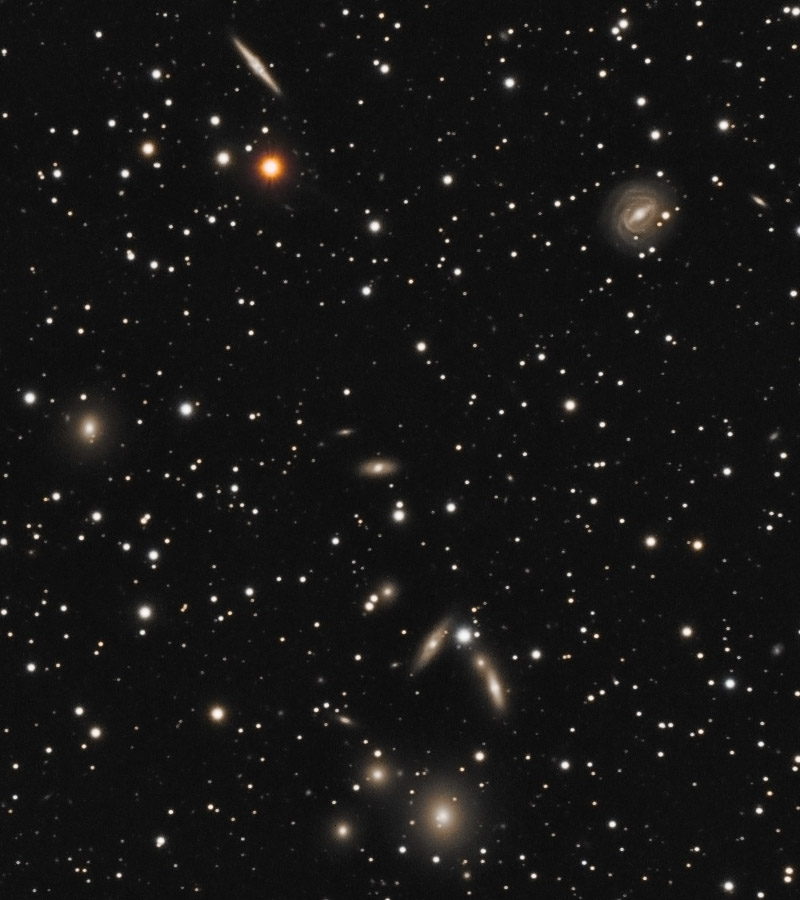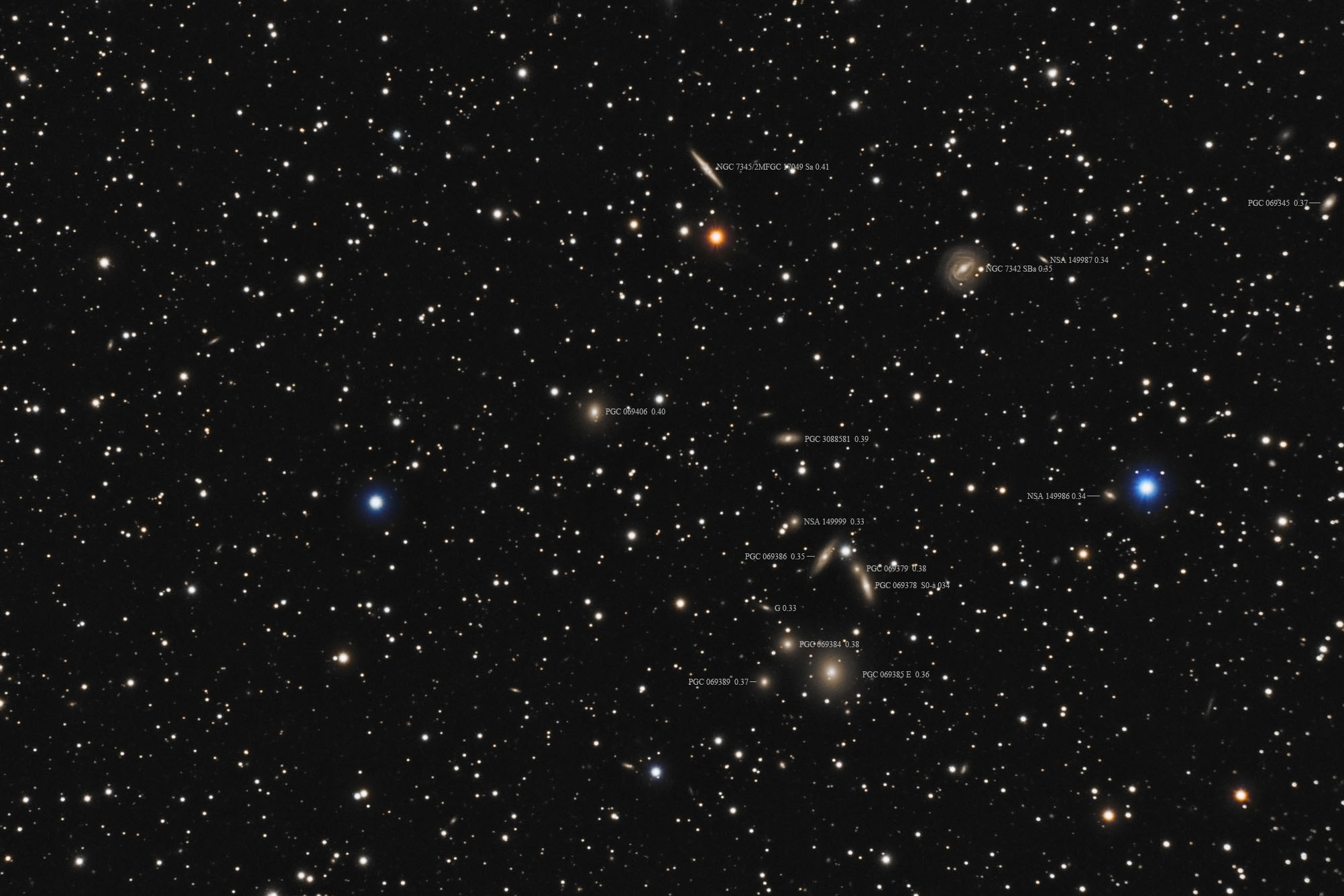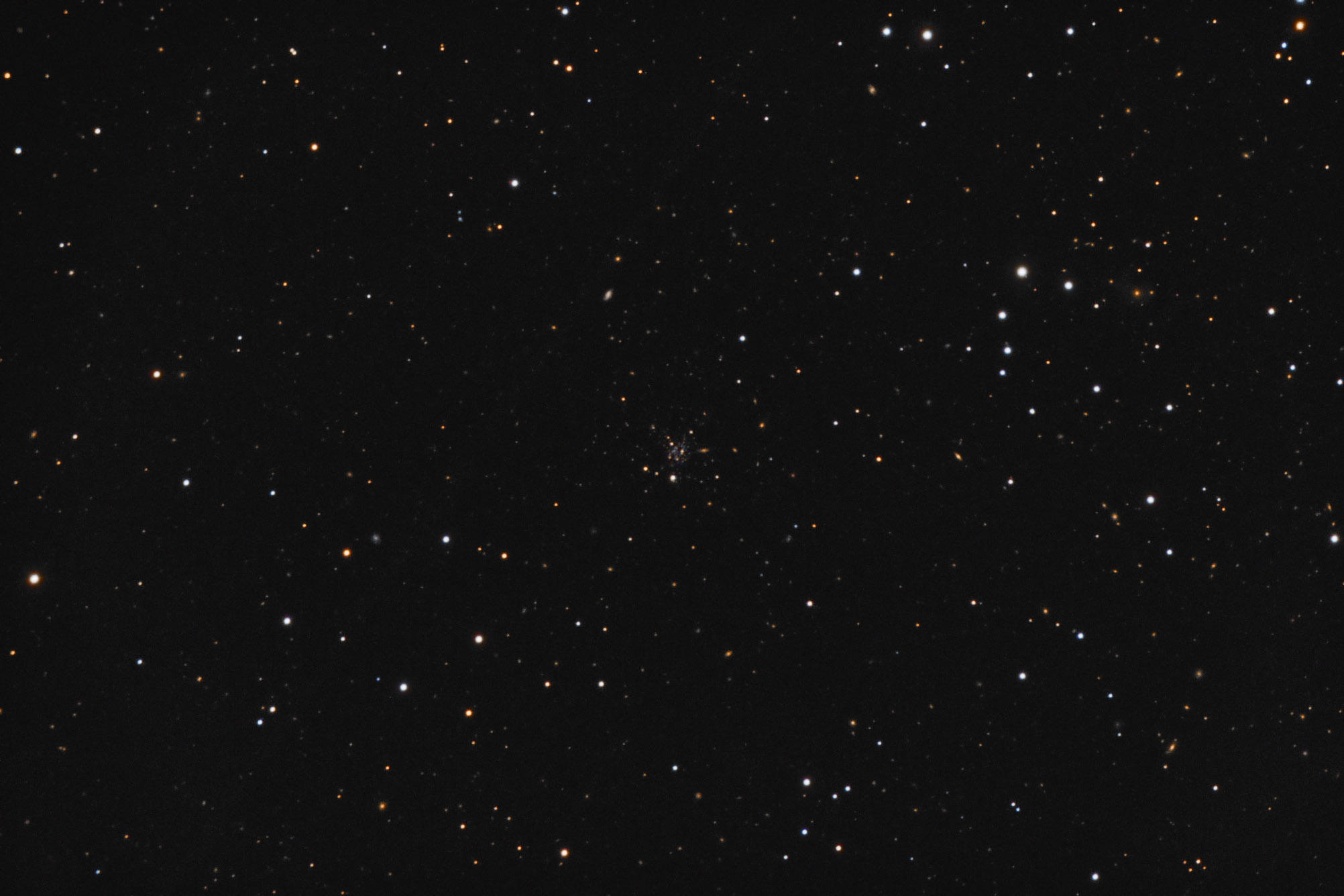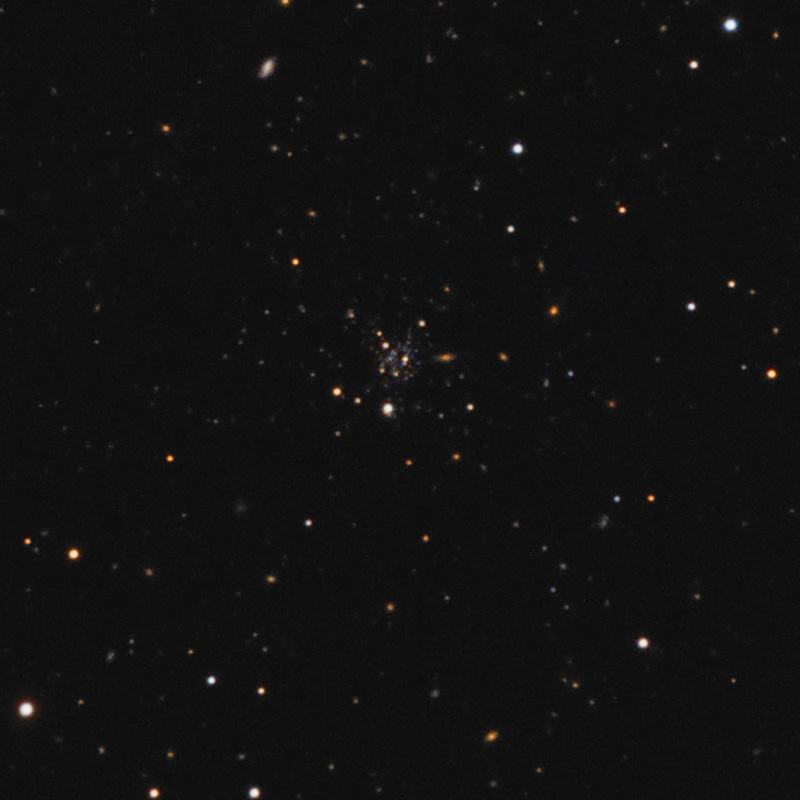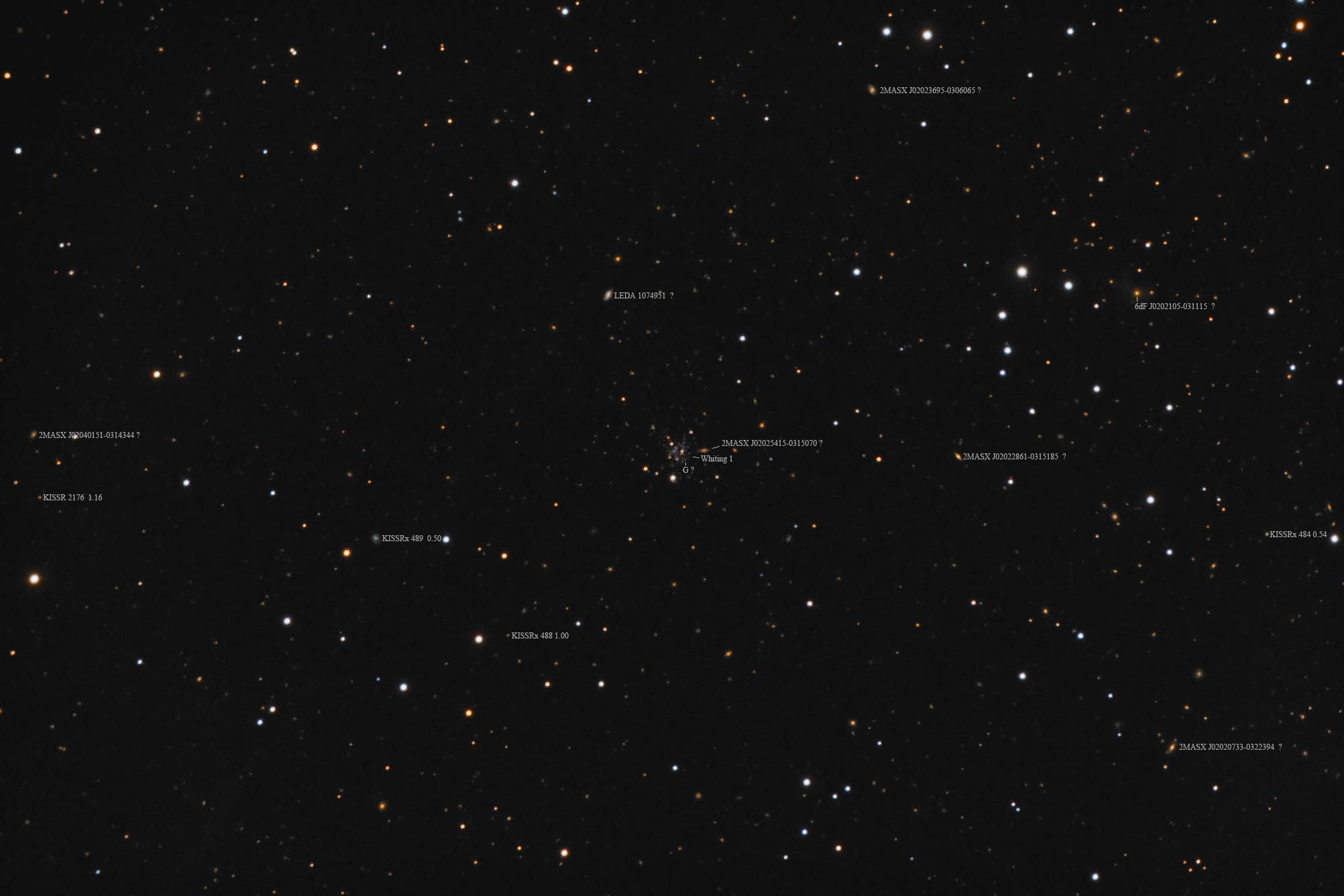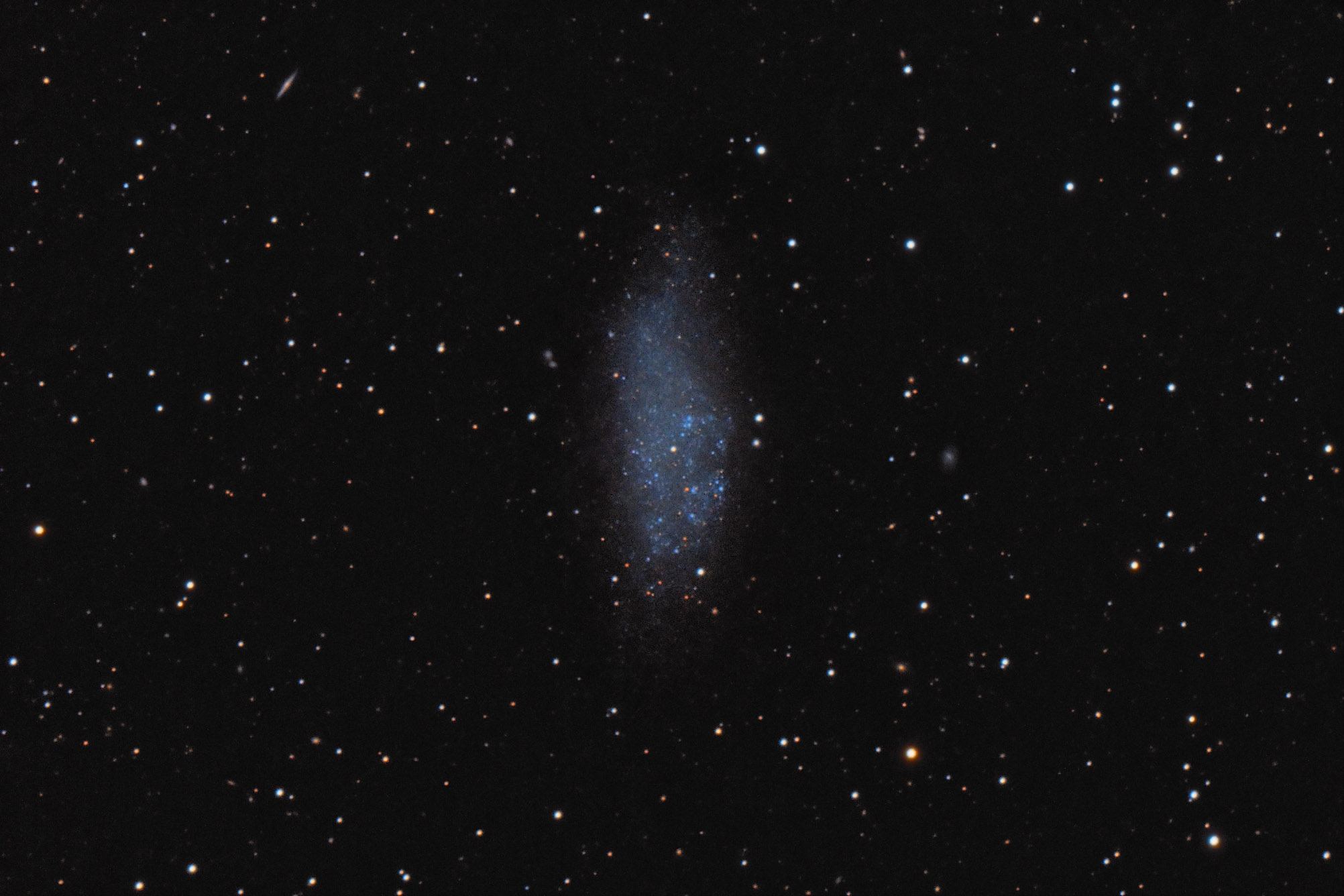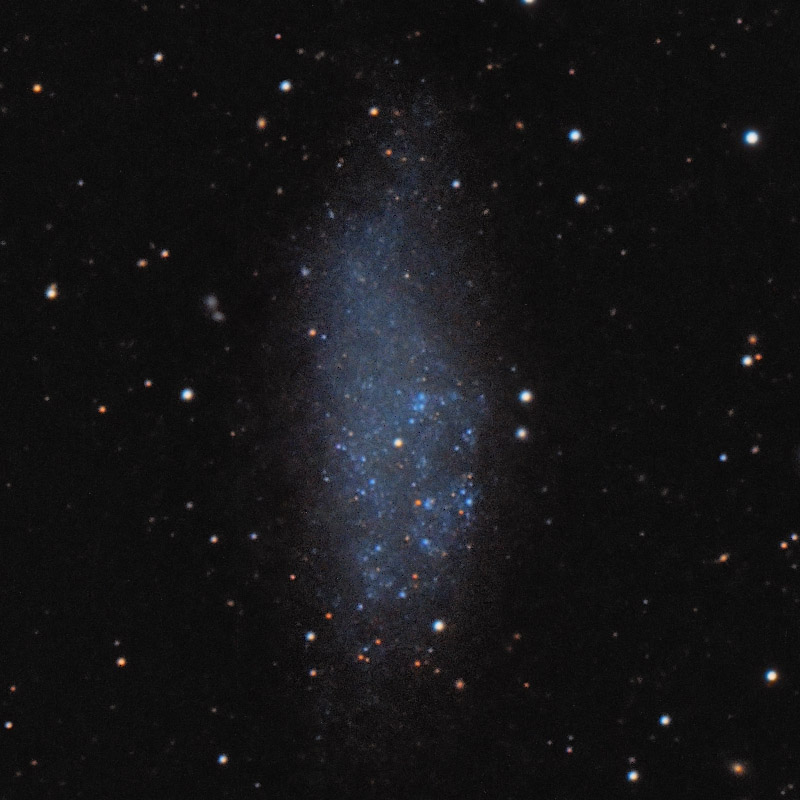| Description | Images | WBL409WBL 409 is a group of three galaxies about 58 million light-years distant in Virgo not far from its major Virgo Cluster galaxies like M84, M86 and M87. These three are red and dead galaxies with little detail to be seen in them, not even the spiral NGC 4440 has any fine detail being mostly a fuzzy red spiral galaxy. IC 3349 is also likely a member of the group though its redshift puts it 80 million light-years out a non-redshift measurement puts it 61 million light-years. The redshift of Virgo cluster members is very wide-ranging and undependable as a distance measure. The three NGC galaxies were discovered by William Herschel on April 17, 1784. For some reason, NGC 4436 is classified as a dwarf elliptical or dwarf S0 galaxy even though it isn't all the much smaller than the other two. Assuming the 58 million light-year distance I measure NGC 4431 at 30,000 light-years, NGC 4436 at 29,000 light-years and NGC 4440 as being 44,000 light-years across None are in either H400 observing program. IC 3349 was discovered over 120 years later by Royal Frost on May 10, 1904. Assuming it too is about 58 million light-years distant I measure it at 16,600 light-years in size. It does deserve its dwarf label. Related Designations for WBL409WBL 409, NGC 4431, UGC 07569, VCC 1010, VPC 0532, CGCG 070-094, CGCG 1224.9+1234, MCG +02-32-062, 2MASX J12272735+1217252, 2MASXi J1227268+121725, 2MASS J12272738+1217248, SDSS J122727.37+121725.0, SDSS J122727.38+121725.0, GALEXMSC J122727.41+121722.2 , WBL 409-001, LDCE 0904 NED122, HDCE 0720 NED098, USGC U490 NED214, HOLM 408C, MAPS-NGP O_496_0063604, NSA 141405, PGC 040852, UZC J122727.4+121725, EVCC 2112, LGG 292:[G93] 006, [M98j] 174 NED107, [RG2008] J186.86409+12.29029 , v2MCG 50:[DMP2012] 2, RSCG 56:[WBJ2013] B, NGC 4436, UGC 07573, VCC 1036, VPC 0544, CGCG 070-096, CGCG 1225.2+1235, MCG +02-32-066, LCSB L0515O, 2MASX J12274122+1218574, 2MASS J12274122+1218572, SDSS J122741.23+121857.2, SDSS J122741.24+121857.2, GALEXASC J122741.38+121856.7 , GALEXMSC J122741.19+121857.4 , WBL 409-002, LDCE 0904 NED125, HDCE 0720 NED101, USGC U490 NED210, ASK 386246.0, HOLM 408A, MAPS-NGP O_496_0063678, NSA 066749, PGC 040903, UZC J122741.3+121857, EVCC 0670, LGG 289:[G93] 010, [RG2008] J186.92183+12.31590 , v2MCG 50:[DMP2012] 3, RSCG 56:[WBJ2013] C, NGC 4440, UGC 07581, VCC 1047, VPC 0560, CGCG 070-099, CGCG 1225.4+1234, MCG +02-32-067, 2MASX J12275357+1217354, 2MASXi J1227535+121735, 2MASS J12275354+1217358, SDSS J122753.56+121735.8, GALEXASC J122753.48+121735.7 , GALEXMSC J122753.48+121734.8 , WBL 409-003, LDCE 0904 NED127, HDCE 0720 NED103, USGC U490 NED208, HOLM 408B, [BEC2010] HRS 164, MAPS-NGP O_496_0063741, NSA 161820, PGC 040927, UZC J122753.6+121736, EVCC 2121, LGG 292:[G93] 007, [M98j] 174 NED110, [RG2008] J186.97320+12.29328 , v2MCG 50:[DMP2012] 1, RSCG 56:[WBJ2013] A, IC 3349, VCC 0940, VPC 0496, CGCG 070-081, CGCG 1224.2+1244, LCSB F0034O, 2MASX J12264704+1227147, SDSS J122647.06+122714.3, SDSS J122647.07+122714.3, GALEXASC J122647.15+122718.0 , GALEXMSC J122647.01+122716.1 , USGC U490 NED231, [R83] 12deg043, AGC 220591, ASK 385509.0, MAPS-NGP O_496_0054940, NSA 066624, PGC 040744, UZC J122647.1+122714, EVCC 0622, LGG 289:[G93] 075, [RG2008] J186.69610+12.45398 , RSCG 56:[WBJ2013] D, WBL409, NGC4431, NGC4436, NGC4440, IC3349, | WBL685This galaxy group is located in northern Pegasus at the border with Lacerta and about 1 degree north of the far more famous Deer Lick Galaxy, NGC 7331. The 6 brightest members are known as the UGC 12127 group and WBL 685. But the group is much larger than this. It is part of the B2 2236+35:[MLO2002] CLUSTER which in turn is part of the Zwicky cluster 2231.2+3732. Each designation has a slightly different distance estimate but it's in the 350 to 400 million light-year range depending on which galaxies redshift you use or average them to about 375 million light-years. Related Designations for WBL685WBL 685, NGC 7342, UGC 12126, CGCG 514-076, CGCG 2235.9+3515, MCG +06-49-054, 2MASX J22381316+3529559, 2MASXi J2238131+352955, 2MASS J22381312+3529557, SDSS J223813.11+352955.7, WBL 685-001, LDCE 1532 NED001, HDCE 1199 NED001, USGC U820 NED08, MAPS-PP O_0778_0859439, NSA 149990, PGC 069374, UZC J223813.2+352956, UZC-CG 280 NED01, [MLO2002] J223813.2+352956, B2 2236+35:[MLO2002] NED06, NGC 7345, UGC 12130, CGCG 514-083, CGCG 2236.4+3517, MCG +06-49-064, 2MFGC 17049, 2MASX J22384486+3532259, 2MASXi J2238448+353225, 2MASS J22384484+3532260, 2MASS J22384499+3532288, WBL 685-005, LDCE 1530 NED005, HDCE 1200 NED002, USGC U820 NED02, MAPS-PP O_0778_0826778, NSA 150004, PGC 069401, UZC J223844.9+353226, UZC-CG 280 NED05, [MLO2002] J223844.7+353225, B2 2236+35:[MLO2002] NED15, WBL685, NGC7342, NGC7345, | WHITING1Whiting 1 isn't much of a globular cluster. It certainly won't win any photogenic awards but it is quite interesting. Most globular clusters are about 10 billion years old, having formed with the galaxy 10 billion years ago. Whiting 1, however, is much younger, probably about 6.5 billion years old. This is possible because it likely didn't form in our galaxy. In fact, it is part of what is known as the Sagittarius Dwarf Elliptical Galaxy (SagDEG) also known as the Sagittarius Dwarf Spheroidal Galaxy. This galaxy, or what's left of it, was discovered in 1994. It is now mostly a stream of stars representing what was this galaxy before our galaxy began digesting it. In 2002 the star group in my image was discovered, three years later it was shown to be what's left of a globular cluster that likely belonged to the SagDEG. Related Designations for WHITING1Whiting 1, GALEXASC J020257.10-031510.5 , WHI B0200-03, [LM2010] 03, WHITING1, | WLMThe Wolf-Lundmark-Melotte galaxy was discovered by Max Wolf as a nebula in 1909. At that time galaxies weren't really recognized. It wasn't until 1926 that Knut Lundmark and P.J. Melotte determined it was a galaxy. It is now recognized as a distant member of the local group being some 3.4 million light-years distant by some sources. NED, using 26 measurements mostly using Tip of the Red Giant Branch and Cepheid variable methods gives a median value of 3.2 million light-years. Others sources say 3.0 million light-years. All agree it is more distant than M31 but like M31 it is moving in our direction and is thus blue shifted. As a member of the local group, it is quite isolated with its nearest neighbor being over 1 million light-years away. That one is the rather well known IC 1613. I do need to retake that one as my data for it from 2007 is awful, especially the color data. The WLM galaxy is located in southwestern Cetus just below my normal 15 degree south declination limit. Fortunately, I had an exceptional night so was able to capture it though not with the detail I'd get if it was up out of the gunk. Related Designations for WLMWolf-Lundmark-Melotte, UGCA 444, DDO 221, MCG -03-01-015, 2MASS J00015816-1527397, CGS 612, [RC2] A2359-15, [RC1] A2359, HIPASS J0001-15, PGC 000143, SSTSL2 J000158.16-152739.6, 11HUGS 002, [SPB93] 276, WLM, |
